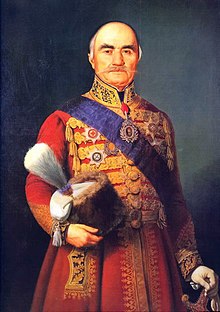Miloš Obrenović
Miloš Obrenović ( Serbian - Cyrillic Милош Обреновић * 19th March 1780 in Dobrinja , district Uzice , as Miloš Teodorović ; † 26. September 1860 in Topčider ) was the leader of the Second Serbian Uprising against the Ottoman Empire in 1815 and won an autonomous Serbian principality in present-day central Serbia . He was founder of the dynasty of the house Obrenovic .
Life
Miloš Teodorović was born in Gornja Dobrinja near Užice in Sanjak Smederevo . His parents were Teodor and Višnja Mihailović. When his father died, his mother Višnja married the cattle dealer Obren Martinović, from whose first name Miloš derived his surname Obrenović. Obren Martinović also died early and Miloš took over the household as the elder. In the meantime, his younger brother Milan was successful in the cattle trade and later introduced Miloš into the business. Milan Obrenović also made contact with Đorđe Petrović, called Karađorđe , who was to become the leader in the first Serbian uprising. Miloš Obrenović was married to Ljubica, nee Vukomanović. He had seven children with her, three of whom died in childhood. Miloš Obrenović himself remained illiterate throughout his life.
When the first Serbian uprising against the Turks began in 1804 , Milan became one of the subordinate leaders of the rebellious Serbs. Miloš Obrenović was with the insurgents from the beginning, but was long in the shadow of his younger brother. Đorđe Petrović Karađorđe was a capable military leader, but in building a Serbian administration and especially in domestic politics, he showed little skill and soon created an opposition that included Milan and Miloš Obrenović. Milan Obrenović was entrusted a diplomatic mission in 1810; he died under dubious circumstances in Bucharest . Miloš Obrenović blamed Karađorđe for the death of his brother.
In 1813 the first Serbian uprising was over and the Serbs were defeated by the Ottomans for the time being. Karađorđe fled to Austria and then to the Principality of Moldova . Miloš Obrenović, meanwhile one of the Serbian subordinates, first surrendered to the Ottomans and supported their policy of oppression in Serbia, but then fell back and organized the second Serbian uprising from April 1815. After defeating a Turkish army in western Serbia, he quickly came into the grip of two Turkish armies and was thereby forced to negotiate. Since Russia stood up for the Serbian cause, Istanbul was also forced to find a negotiated solution.
Obrenović was appointed Serbian prince under Turkish sovereignty, but the hegemonic power traded more and more concessions to Serbian autonomy in the following years. At the same time, his rule took on increasingly despotic features. In 1817 he had Karađorđe killed and sent his head to Istanbul as a token of his devotion . He did not allow the formation of a council of state, which had been requested several times. In 1830 the Ottomans had to recognize the de facto independence of Serbia (although the formal independence did not begin until 1878 under international law), and Miloš Obrenović became hereditary prince.
In 1838 Russia and the Ottoman Empire jointly imposed a constitution with a State Council on him. He then left his official business to his son Milan. 1842 ousted Aleksander Karađorđević , the son of the murdered Karadjordje, Miloš's son and second successor Mihailo as Serbian prince, whereupon Miloš Obrenović went into exile in Vienna. There he left u. a. by Johann Strauss the Serbs Quadrille compose. After Alexsander had been deposed in 1858, Miloš Obrenović returned to Serbia and was again prince, but only two years until his death in 1860. His son Mihailo was again his successor.
Appreciation
In memory of the monarch, a traditional mineral water brand Knjaz Miloš has been named after him since 1811 . There are also monuments in Požarevac and Takovo that commemorate him. A replica of the monument by the sculptor Petar Ubavkić , erected in Takovo in 1900 , was placed on Ulica Kneza Miloša in Belgrade in 2004 .
literature
- Edgar Hösch, Karl Nehring, Holm Sundhaussen: Lexicon of the history of Southeast Europe. Böhlau, Cologne / Weimar / Vienna, 2004, pp. 484/485.
Individual evidence
- ↑ Spomenik Milošu Obrenoviću u ulici Kneza Milosa. www.b92.net, September 5, 2003.
| predecessor | Office | successor |
|---|---|---|
| Karađorđe |
Prince of Serbia 1815–1839 |
Milan II. |
| Alexander I. |
Prince of Serbia 1858–1860 |
Mihailo III. |
| personal data | |
|---|---|
| SURNAME | Obrenović, Miloš |
| BRIEF DESCRIPTION | Serbian prince |
| DATE OF BIRTH | March 19, 1780 |
| PLACE OF BIRTH | Srednja Dobrinja |
| DATE OF DEATH | September 26, 1860 |
| Place of death | Topčider |


